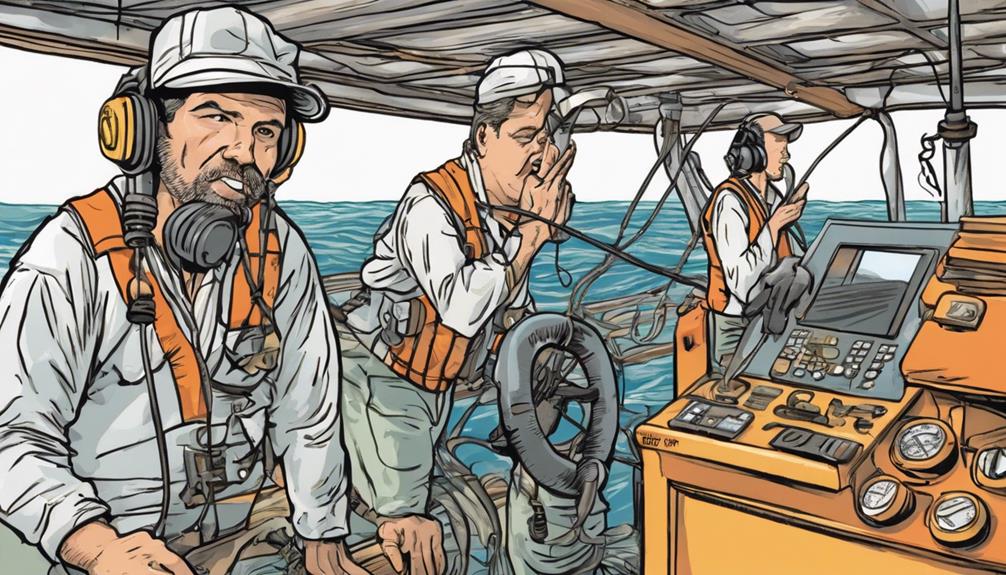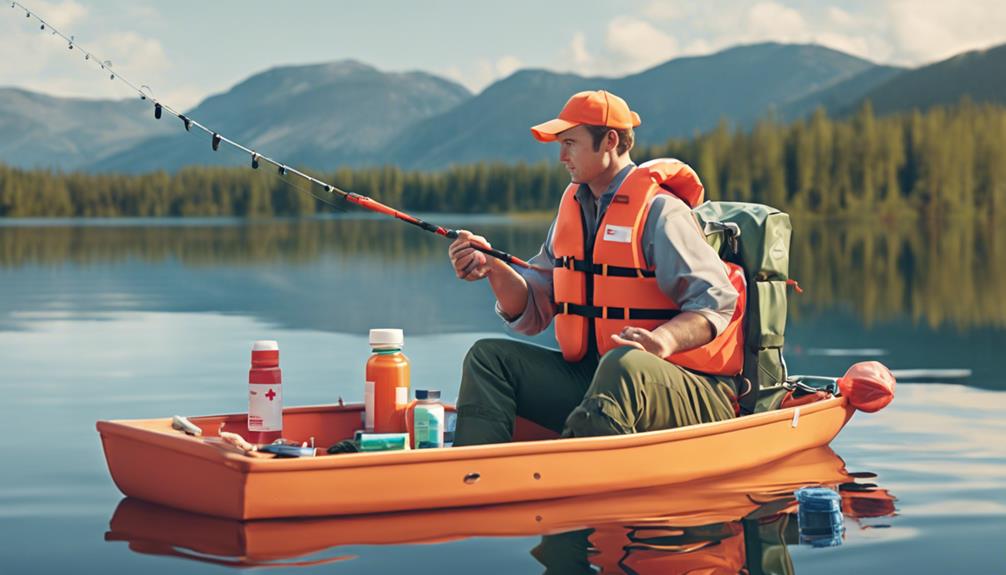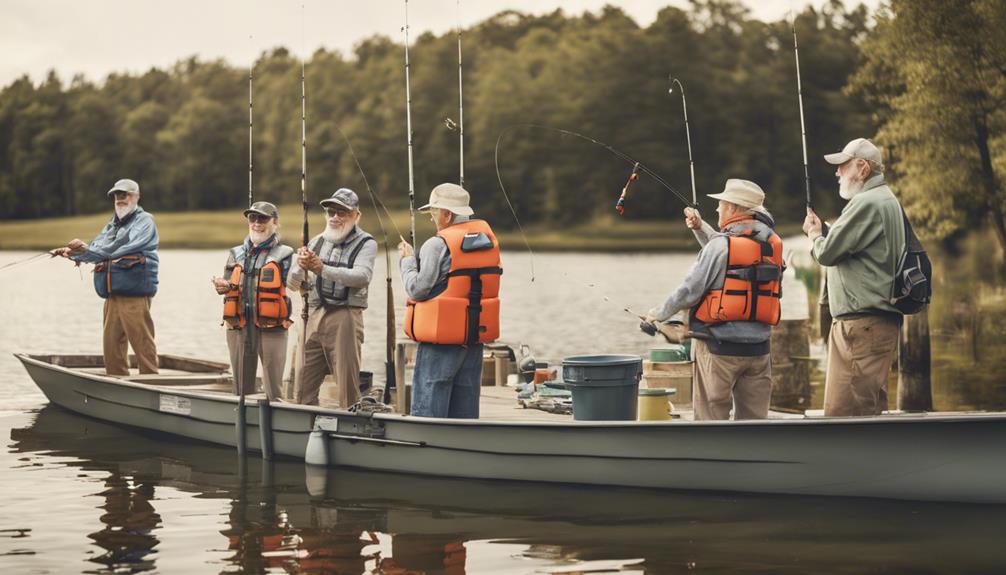When it comes to commercial fishing, the old saying 'safety first' truly applies. Ensuring the well-being of yourself and your crew should be paramount in your operations.
From personal protective equipment to emergency response procedures, each aspect plays a crucial role in keeping everyone safe at sea.
As you navigate the waters, these 13 key safety protocols will not only protect lives but also safeguard your livelihood.
Importance of Safety Protocols
To ensure the well-being of crew members and minimize risks, implementing safety protocols is imperative in commercial fishing. Risk assessment plays a crucial role in identifying potential hazards that crew members may encounter while out at sea. By conducting thorough risk assessments, you can proactively address dangers such as extreme weather conditions, equipment malfunctions, or slippery decks, reducing the likelihood of accidents occurring.
Moreover, fostering a strong safety culture within your team is essential. This involves instilling a mindset where safety is prioritized above all else. Encouraging open communication about safety concerns, providing regular training on emergency procedures, and promoting a zero-tolerance policy for risky behavior are all key components of a robust safety culture. When every crew member understands the importance of adhering to safety protocols, the entire operation becomes more secure.
Personal Protective Equipment (PPE)
Implementing Personal Protective Equipment (PPE) is crucial for ensuring the safety of crew members in commercial fishing operations. PPE effectiveness is greatly influenced by the proper usage and maintenance of the equipment.
Here are some key points to consider regarding PPE:
- Fit Matters: Ensuring that each crew member has PPE that fits properly is essential. Ill-fitting gear can be uncomfortable and may not provide adequate protection in case of an emergency.
- Regular Inspections: Regularly inspecting PPE for signs of wear and tear is vital. Damaged equipment should be replaced immediately to maintain its effectiveness.
- Training and Education: Proper training on how to use PPE correctly is crucial. Crew members should be educated on the importance of wearing PPE at all times and following safety protocols.
Vessel Safety Measures
Ensuring the proper maintenance of safety equipment on board is essential for implementing effective vessel safety measures in commercial fishing operations. Conducting regular vessel inspections is crucial to identify any issues that may compromise the safety of the crew. During these inspections, make sure all safety equipment, such as life rafts, life jackets, fire extinguishers, and emergency lights, are in good working condition and easily accessible in case of an emergency.
Proper safety equipment placement is key to a quick response in hazardous situations. Life-saving devices should be strategically located throughout the vessel, with clear signage indicating their positions. Additionally, all crew members should be familiar with the location and proper use of safety equipment to ensure a swift and efficient response to emergencies.
When conducting vessel inspections, pay close attention to the expiration dates of safety equipment such as flares and fire extinguishers. Replace any expired items immediately to maintain a high level of safety on board. Regular maintenance and testing of safety equipment are essential to guarantee that they'll function correctly when needed most.
Emergency Response Procedures
Effective emergency response procedures are crucial for maintaining crew safety in commercial fishing operations. Being prepared for any unforeseen circumstances can make a significant difference in ensuring the well-being of everyone on board.
To enhance your emergency response readiness, consider the following key points:
- Emergency Drills: Regularly conducting emergency drills is essential for familiarizing the crew with different scenarios and protocols. These drills help everyone understand their roles and responsibilities during an emergency situation, ensuring a coordinated and efficient response.
- Response Training: Providing comprehensive training on emergency response protocols is vital. All crew members should be well-versed in procedures such as man overboard situations, fire emergencies, and abandon ship protocols. Training should be a continuous process to keep everyone prepared and informed.
- Communication Protocols: Establish clear communication protocols to ensure effective coordination during emergencies. Designate specific individuals or roles responsible for communicating distress signals, relaying information to relevant authorities, and coordinating responses among crew members.
Weather Monitoring and Alerts
To ensure the safety of your crew amidst potential weather-related hazards, monitoring weather conditions and receiving timely alerts are essential practices in commercial fishing operations. Forecast accuracy plays a crucial role in preparing for adverse weather conditions. By utilizing reliable weather forecasting services, you can stay ahead of changing weather patterns and make informed decisions about whether to head back to port or seek shelter.
In addition to monitoring weather forecasts, having effective alert systems in place is vital for prompt emergency response. Implementing alert systems that provide real-time updates on approaching storms or other dangerous weather phenomena can help you proactively protect your crew and vessel. It's essential to establish clear communication strategies within your team to ensure that everyone receives and understands weather alerts promptly. Regular drills and discussions on how to respond to different weather scenarios can help streamline emergency procedures and improve overall safety measures.
Crew Training and Drills
For optimal crew readiness and operational safety, prioritize regular training sessions and drills onboard your commercial fishing vessel. This practice ensures that your crew is well-prepared to handle emergencies and operate efficiently in challenging situations. By conducting safety simulations and drills, you can enhance team cohesion and response effectiveness.
- Safety Simulations: Implement various safety simulations onboard to prepare your crew for different emergency scenarios. These simulations can include man overboard drills, fire drills, and abandon ship procedures. By practicing these simulations regularly, your crew will be more confident and capable when faced with real-life emergencies.
- Team Cohesion: Foster a sense of unity and collaboration among your crew members through training and drills. Encourage open communication, mutual support, and clear roles and responsibilities during exercises. Strong team cohesion is essential for effective coordination and quick decision-making during emergencies.
- Continuous Improvement: Regularly assess the effectiveness of your training sessions and drills. Gather feedback from your crew members to identify areas for improvement and adjust your training program accordingly. Continuous learning and enhancement of skills will contribute to a safer working environment and better overall performance on your commercial fishing vessel.
Communication Protocols

Prioritize establishing clear and efficient communication protocols onboard your commercial fishing vessel to ensure seamless coordination and swift response during emergencies. Effective communication is crucial for the safety of everyone on board. Make sure all crew members understand and adhere to the communication protocols in place. This includes using standardized language, clear terminology, and concise instructions to avoid any misunderstandings.
Teamwork dynamics play a significant role in ensuring that communication flows smoothly. Encourage open communication among crew members and foster a supportive environment where everyone feels comfortable speaking up. Establishing designated channels for communication based on different scenarios can help streamline information flow and decision-making processes during critical situations.
Regular drills and training exercises focusing on communication protocols can help reinforce the importance of effective communication onboard. Practice scenarios that require quick responses and coordination among crew members to enhance teamwork dynamics. By consistently training and honing these skills, your crew will be better prepared to handle emergencies and work together efficiently to ensure the safety of all individuals on the vessel. Remember, clear and effective communication is the key to a successful and safe commercial fishing operation.
Compliance With Regulations
Establishing and maintaining compliance with regulations is essential for ensuring the safety and legality of your commercial fishing operations. Regulatory compliance isn't just about avoiding fines or penalties; it's about protecting yourself, your crew, and the marine environment. Here are some key points to consider regarding compliance with regulations:
- Stay Informed: Keep yourself updated on the latest regulations and requirements set forth by relevant authorities. Regularly check for any changes or updates to ensure your operations remain compliant.
- Document Everything: Maintain detailed records of your fishing activities, including licenses, permits, catch reports, and safety inspections. Having organized documentation won't only help you stay compliant but also serve as crucial evidence in case of audits or inspections.
- Train Your Crew: Ensure that all members of your crew are well-informed about regulatory requirements and safety protocols. Conduct regular training sessions to explore compliance practices and enforce a culture of safety onboard.
Enforcement measures for regulatory compliance can vary, ranging from warnings and fines to vessel detentions or license revocations. By proactively complying with regulations and implementing stringent safety measures, you can protect your business, your crew, and the marine ecosystem. Remember, compliance is a continuous process that requires diligence and commitment.s.
Frequently Asked Questions
What Are Some Common Injuries That Can Occur While Working on a Commercial Fishing Vessel?
Common injuries that can occur while working on a commercial fishing vessel include cuts, bruises, sprains, and even more severe incidents like fractures or head injuries.
It's crucial to have proper first aid knowledge and safety training to handle these situations effectively. Understanding how to address these injuries promptly can make a significant difference in the overall well-being and health of everyone on board.
How Often Should Emergency Drills Be Conducted on a Commercial Fishing Vessel?
Emergency preparedness is crucial on a commercial fishing vessel. Regularly conducting emergency drills is essential to ensure everyone is prepared for potential emergencies. By practicing these drills frequently, response times can be improved, and safety onboard can be increased. Prioritizing emergency preparedness by scheduling drills at regular intervals helps keep skills sharp and reactions swift in case of any unforeseen situations.
Make sure to conduct emergency drills regularly on the vessel to maintain a high level of preparedness. This practice not only ensures that all crew members know their roles and responsibilities but also helps identify areas for improvement. Training sessions should cover various emergency scenarios, such as fires, man overboard, or medical emergencies, to prepare the crew for a wide range of situations. By emphasizing the frequency of drills, you establish a culture of readiness that can make a significant difference in the event of an actual emergency.
Are There Specific Safety Protocols for Handling Hazardous Materials on Board a Fishing Vessel?
When handling hazardous materials on a fishing vessel, it's crucial to follow specific safety protocols. Proper training is essential for all crew members to ensure they know how to handle these materials safely.
Additionally, safety equipment should be readily available and in good condition. Hazardous materials should be stored according to regulations to minimize risks.
Regular drills and updates on safety procedures can help maintain a safe working environment aboard the vessel.
What Steps Should Be Taken to Prevent Fatigue-Related Accidents Among Crew Members?
To prevent fatigue-related accidents among crew members, prioritize crew wellness. Encourage adequate rest periods and limit work hours.
Schedule regular breaks and promote healthy lifestyle choices onboard. Implement a fatigue management plan, including awareness training and monitoring fatigue levels.
Address any concerns promptly and ensure crew members feel supported in maintaining their well-being. By focusing on preventing fatigue, you can enhance safety and productivity on the fishing vessel.
How Can Commercial Fishing Vessels Ensure Proper Maintenance of Safety Equipment and Tools?
To ensure proper maintenance of safety equipment and tools on commercial fishing vessels, it is essential to regularly inspect all gear. Replace damaged items promptly and conduct training drills to familiarize crew members with equipment.
Store hazardous materials properly and follow safety guidelines. Implement fatigue prevention strategies to maintain crew safety.
Conclusion
Remember, safety should always be your top priority when working in commercial fishing. By following these key safety protocols, you can help ensure the well-being of yourself and your crew.
From wearing proper PPE to conducting regular drills and monitoring weather conditions, every precaution counts. Stay informed, stay prepared, and always be ready to respond in case of emergency.
Your commitment to safety won't only protect you and your colleagues but also contribute to a successful and sustainable fishing operation.



